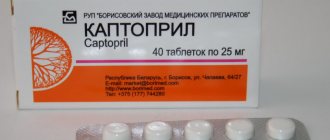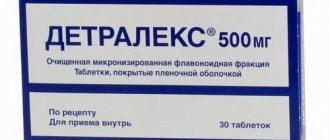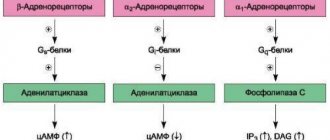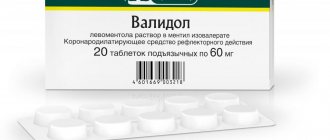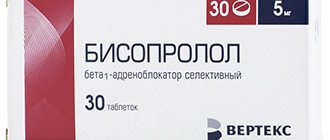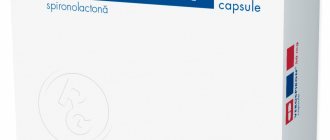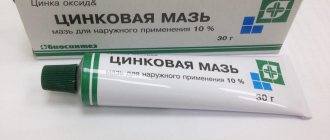Active substance, action, release form
"Hipotel" refers to sartans or angiotensin 2 receptor antagonists. The main active ingredient of the drug is telmisartan. Like other drugs in this group, it reduces blood pressure by selectively blocking AT2 receptors (type 2). After blocking the receptors, the lumen of the blood vessels expands, and the excretion of water and sodium in the urine increases. While taking Hypotel, side effects such as cough or angioedema do not develop, since telmisartan does not participate in the metabolism of bradykinin. Among the positive effects of sartans on the body, researchers highlight the ability to reduce the development and enlargement of the heart muscle. There is a protective effect on target organs: heart, eyes, kidneys.
Enter your pressure
Move the sliders
120
on
80
The hypotensive effect lasts for 24 hours. The maximum effect is achieved in the 6th week of continuous use of the drug. The drug "Hipotel" does not have the ability to accumulate in the body, and therefore requires constant use for a reliable and long-lasting effect. They produce 20, 40 and 80 mg of the active substance in one tablet.
Hipotel is a drug for the treatment of essential hypertension and diseases of the cardiovascular system
Hypotel is an effective drug created by the pharmaceutical company Kusum Healthcare Pvt.
Ltd. It is intended for the treatment of essential hypertension in adult patients. This medication is also widely used to prevent the development of complications of cardiovascular diseases in patients who suffer from type II diabetes mellitus or manifest atherothrombotic diseases.
The drug is based on telmisartan, which is an effective angiotensin II receptor antagonist. Before using the drug Hipotel, you should study in detail its important characteristics, pharmacological characteristics and rules of use.
Release form and composition
The drug Hypotel is available in the form of tablets, packaged in blisters and cardboard tablets. Packages containing 10 and 14 tablets are available.
The main active ingredient of this medication is telmisartan, which belongs to the category of selective angiotensin II receptor antagonists and is widely used in the treatment of arterial hypertension.
The concentration of this component in one tablet can be 20, 40 and 80 mg.
The composition also contains excipients:
- mannitol (E 421);
- sodium hydroxide;
- magnesium stearate;
- crospovidone;
- meglumine
Indications for use
Hipotel tablets are prescribed in the following cases:
- in the treatment of arterial hypertension;
- in order to prevent serious complications and mortality from diseases of the cardiovascular system in patients who have had a heart attack or stroke, or who have a history of peripheral artery disease;
- in order to prevent the development of diseases of the cardiovascular system in patients suffering from type 2 diabetes mellitus in the presence of documented target organ damage.
pharmachologic effect
The main purpose of the drug Hipotel is the treatment of arterial hypertension. Its main active ingredient telmisartan is a selective angiotensin II receptor antagonist.
In order to completely eliminate the increase in blood pressure caused by angiotensin II, a dose of the drug of 80 mg will be required.
In this case, the maximum therapeutic effectiveness can be maintained throughout the day, after which it begins to gradually decrease. In this case, the patient feels significant relief over the next two days.
The active substance of the drug leads to a decrease in the level of aldosterone contained in human blood. It does not have a suppressive effect on the action of renin and ACE inhibitors, and also does not block the channels that are responsible for the process of ion conduction.
For arterial hypertension, the drug helps reduce systolic and diastolic pressure without affecting the patient's pulse rate.
Mode of application
Hipotel tablets are intended for oral administration, regardless of the time of eating. The optimal daily dosage is prescribed by the attending doctor.
In most cases, it is 40 mg, although sometimes 20 mg is sufficient to achieve the required therapeutic effect.
If it is impossible to achieve the desired effect with a dosage of 40 mg, it is increased to 80 mg - this is the maximum value, exceeding which is unacceptable. For patients with moderate liver dysfunction, the maximum daily dosage is 40 mg of the drug.
The frequency of taking Hipotel tablets is once a day.
Adjustment of the initial dosage should be carried out only in exceptional cases, given that to achieve the best therapeutic result it will take approximately 1-2 months of regular use of the drug.
Interaction with other drugs
When starting a therapeutic course, it is necessary to take into account all the features of the interaction of Hipotel tablets with other types of medications.
When Hypotel is taken simultaneously with other drugs intended for the treatment of arterial hypertension - for example, Amifostine and Baclofen - there is an increase in the hypotensive effect of all these drugs.
The combination of Hipotel tablets with antidepressants, barbiturates, ethanol and narcotic drugs leads to an increased risk of orthostatic hypotension.
The hypotensive effect increases when Hypotel is taken simultaneously with certain diuretics, in particular Hydrochlorothiazide and Furosemide.
As a result of joint administration with Digoxin, its concentration in plasma increases.
The effectiveness of the active ingredient telmisartan increases when Hipotel tablets are taken together with Amlopidine.
When combined with lithium preparations, the concentration of this element in human blood increases. This phenomenon is reversible.
Side effects
In general, the drug Hypotel is well tolerated by patients. Side effects may affect approximately one person in a thousand, but you should be fully aware of them.
In extremely rare cases, this telmisartan-based drug may cause:
- arterial and orthostatic hypotension;
- pharyngitis, sinusitis and other upper respiratory tract infections;
- cystitis, sepsis and other types of infections of the genitourinary system;
- depression, insomnia, feelings of anxiety and restlessness;
- thrombocytopenia, anemia, eosinophilia;
- in patients with diabetes mellitus – hypoglycemia and hyperkalemia;
- visual impairment;
- tachycardia and bradycardia;
- cough, shortness of breath and interstitial lung disease;
- pain and discomfort in the abdomen, flatulence, dyspepsia, vomiting and dry mouth;
- dysfunction of the liver and kidneys;
- myalgia, muscle spasms, tendon soreness, arthralgia;
- chest pain, general weakness, and flu-like symptoms;
- dermatitis, urticaria, eczema.
Overdose
If the permissible daily dosage of the drug is exceeded, the following side effects may occur:
- significant decrease in blood pressure;
- severe dizziness;
- tachycardia and bradycardia;
- severe renal failure;
- an increase in the level of creatinine in the blood.
In case of overdose of the drug, symptomatic therapy should be carried out as soon as possible. It is also very important to monitor plasma creatinine and electrolyte levels and, if necessary, adjust them.
Contraindications
The main contraindications to the use of Hipotel tablets are:
- hypersensitivity to the main active ingredient;
- individual intolerance to the components of the drug;
- severe hepatic dysfunction;
- obstructive biliary disorders;
- age up to 18 years.
During pregnancy
Women in the second and third trimesters of pregnancy are contraindicated to take Hipotel tablets, as this drug can cause neonatal toxicity and phototoxicity.
Due to the fact that today there is no information on the effect of the active substance, telmisartan, on breast milk, Hipotel should not be taken during lactation.
Storage conditions and periods
The shelf life of Hipotel tablets is three years from the date of manufacture. They must be stored in their original packaging, placed in a dark and dry place, out of reach of children, at a temperature not exceeding +25 °C.
After the expiration date, further use of the drug is unacceptable.
Hipotel tablets are available only by prescription. In Russian pharmacies they can be purchased at prices ranging from 200 to 530 rubles.
Pharmacies in Ukraine currently offer this drug for approximately 86-195 hryvnia per package.
Analogs
The drug Hipotel has several effective analogues intended for the treatment of arterial hypertension and the prevention of severe complications of cardiac diseases.
All similar drugs have a common active ingredient and pharmacological properties. The most effective and popular among them include:
Before choosing the most suitable analogue of Hipotel tablets, it is recommended to consult with a qualified doctor, who, based on the individual characteristics of the patient, will select the most effective and safe option.
Reviews
Due to its easy tolerability and convenient method of administration, the drug Hipotel receives many positive reviews. Patients note a fairly rapid effect in the treatment of arterial hypertension.
Some of them are confused by the large list of side effects, but in practice they can be avoided by following all the rules of use and not exceeding the therapeutic dose.
You can read patient reviews in detail at the end of this article. And if you yourself have completed a course of therapy with the drug Hipotel, be sure to share your impressions - your review will be very useful to readers.
Results
When starting to take the drug Hipotel, it is important to understand the following points:
These tablets should not be taken by young people under 18 years of age.- The drug is contraindicated for women during pregnancy and lactation.
- The daily dosage can range from 20 to 80 mg of the drug, depending on the individual characteristics of the patient.
- In case of overdose, symptomatic therapy must be started immediately.
- It is unacceptable to consume alcoholic beverages during the entire course of treatment - violation of this rule leads to the development of orthostatic hypotension.
Indications for use
The effectiveness of the drug has been proven in the treatment of arterial hypertension.
The main indication for the use of the drug is the presence of arterial hypertension (essential or secondary) in adults. The next group of indications includes patients at risk of developing cardiovascular complications: heart attacks, strokes, vascular damage of the lower extremities. Patients with type 2 diabetes mellitus with damage to the kidneys or retinal vessels are also treated.
Instructions for use "Hipotel"
For the treatment of hypertension, a dose of 80 mg of telmisartan is used when the standard 40 mg is not effective and target blood pressure levels are not achieved (< 140/90 mmHg). To prevent cardiovascular complications, Hipotel is used at a dose of 80 mg per day. The tablets are taken once a day, regardless of meals. For the first month, it is recommended to take it on an empty stomach in the morning, without skipping it.
Features of use during pregnancy or breastfeeding
The use of the medication is contraindicated during pregnancy.
During pregnancy, it is absolutely contraindicated to prescribe sartans, as they have a toxic effect on the development of the fetus. Potential adverse effects in neonates include cranial hypoplasia, anuria, hypotonia, renal failure, and death. You should stop taking Hypotel if pregnancy is confirmed. If the angiotensin 2 receptor antagonist cannot be stopped, then a sonographic examination (ultrasound) should be performed, and the mother should be informed about the possible risks. There is no information on the use of telmisartan during breastfeeding, but alternative treatment that has proven safety is preferred.
How is it used in children?
The drug is contraindicated for persons under 18 years of age, since there is no evidence base for the effective use of Hypotel in children. There are no direct indications for the use of sartans in children; for similar pathologies, drugs that are harmless to the development of the child are used. In laboratory conditions, it has been proven that the maximum concentration is achieved in the same way as in adults - within 6–8 hours from the time of taking the drug.
Hipotel tablet 80 mg No. 28
HIPOTEL
Warehouse:
dyucha speech: telmisartan;
1 tablet with telmisartan 20 mg, 40 mg or 80 mg;
additional ingredients: sodium hydroxide, meglumine, mannitol (E 421), crospovidone, magnesium stearate.
Medicine form. Pills.
Pharmacotherapeutic group. Simple angiotensin II antagonist drugs.
ATS code C09C A07.
Clinical characteristics.
Showing.
Treatment of essential hypertension in adults.
Pregnancy of cardiac-vascular illnesses in patients with:
- manifest atherothrombotic cardiovascular disease (ischemic heart disease, stroke or history of peripheral artery disease) or
- type 2 diabetes due to documented damage to target organs.
Contraindicated.
- Hypersensitivity to the drug;
- another and third trimester of gestation;
- obstructive biliary disorders;
- severe impairment of liver function.
In cases of rare seizures, due to which there may be inconsistency with a similar drug, taking Hipotel is contraindicated.
Method of congestion and dosage.
Treatment of essential hypertension. The most effective dose is 40 mg per dose. For certain patients, a further dose of 20 mg may be sufficient. In cases of epilepsy, if the effect is not achieved, the dose of telmisartan can be increased to 80 mg 1 time per dose. Alternatively, telmisartan may be used in combination with thiazide diuretics, such as hydrochlorothiazide, which have been shown to further reduce arterial pressure when taken concomitantly with telmisartan. If a higher dosage is considered, it is necessary to take into account that the maximum antihypertensive effect in general is achieved after 4–8 days of treatment.
In the wake of heart-judgment illnesses. The recommended dose is 80 mg once per dose. The effectiveness of telmisartan in doses less than 80 mg in advanced cardiovascular diseases is unknown.
At the beginning of treatment with telmisartan for the prevention of cardiovascular disease, it is recommended to monitor arterial pressure and, if necessary, adjust the dose of drugs that reduce arterial pressure.
Hypotel can be taken with or without it.
Particular groups of patients.
Damage to the function of the nirok. For patients with lung deficiency and intermediate levels of severity, there is no need for adjusted doses. There is evidence for the treatment of patients with nitric deficiency or patients who are on hemodialysis or obstructions. For such patients, it is recommended to start treatment with a low dose of 20 mg.
Impaired liver function. For patients with mild or moderately impaired liver function, the dose does not need to exceed 40 mg 1 time per dose (section “Peculiarities of stagnation”).
Summer age patients. There is no need for adjusted doses for summer age patients.
Adverse reactions.
In the skin group, side effects are presented in the order of varying degrees of severity.
Infections and invasions: infections of the upper respiratory tract, including pharyngitis and sinusitis, infections of the respiratory tract, including cystitis, sepsis, etc. with a lethal legacy.
On the side of the blood and lymphatic system: anemia, thrombocytopenia, eosinophilia.
On the side of the immune system: hypersensitivity, anaphylactic reaction.
Metabolism and food disorders: hyperkalemia, hypoglycemia (in diabetic patients).
Mental disorders: depression, sleeplessness, restlessness.
On the side of the nervous system: syncope.
On the side of the organs of the eye: destruction of the eye.
On the side of the vestibular apparatus: vertigo.
Cardiac disorders: bradycardia, tachycardia.
Judicial disorders: arterial hypotension, orthostatic hypotension.
On the side of the respiratory system, the organs of the chest and the mediastinum: dyspnea, cough, interstitial illness.
Gut-intestinal disorders: abdominal pain, diarrhea, dyspepsia, flatulence, vomiting, discomfort in the gut, dry mouth.
Disorders of the hepatobiliary system: impaired liver function/liver disorders.
On the side of the skin and pelvis: severe sweating, itching, viscera, erythema, angioedema (including lethal lesions), drug-induced dermatitis, toxic dermatitis, eczema, urticaria.
On the side of the musculoskeletal system and related tissues: myalgia, back pain (such as sciatica), swelling of the muscles, arthralgia, pain in the ends, pain in the tendon (symptoms similar to tendinitis).
On the side of the genitourinary system: impaired function of the nerves, including gastrointestinal deficiency.
General disorders: pain in the chest, asthenia (weakness), flu-like symptoms.
Laboratory data: increased creatinine in the blood, increased sechoic acid in the blood, increased liver enzymes, increased level of creatine phosphokinase (CPK) in the blood, decreased hemoglobin.
Overdose.
Information has been shared regarding overdose in people.
Symptoms The most significant manifestations of overdose of telmisartan were arterial hypotension and tachycardia; Bradycardia, confusion, increased creatinine concentration in serum and acute nitric deficiency have also been reported.
Therapy. Telmisartan is not indicated for hemodialysis.
Patients must be kept under close control and receive symptomatic and supportive therapy. Therapy should be based on the time period after taking the drug and the severity of symptoms. Recommended steps include vomiting and/or washing the mucus. During overdose therapy, it is possible to stagnate the active substances of vugill. It is necessary to frequently check the level of electrolytes and creatinine in the serum. In case of severe arterial hypotension, the patient should be placed on his back and given additional help to increase the volume of salt in the body.
Suspension during pregnancy or breastfeeding.
The use of angiotensin II receptor antagonists is not recommended during the first trimester of pregnancy. The use of angiotensin II receptor antagonists is contraindicated during the second and third trimesters of pregnancy (section “Contraindications”).
There is no sufficient data on the administration of telmisartan to vaginal administration.
Since continued therapy with angiotensin II receptor antagonists is not strictly necessary, patients planning to become pregnant should switch to antihypertensive medications, which may be recommended by the professional. For the safety of drying during wet periods. If treatment with angiotensin II receptor antagonists is established, it is necessary to discontinue treatment and, if necessary, begin an alternative treatment. In the second and third trimesters of pregnancy, angiotensin II receptor antagonism appears to cause fetotoxicity (decreased breast function, oligohydramniosis, obstruction of the formation of cranial cysts) and neonatal toxicity (nirkova insufficiency). yes, hypotension, hyperkalemia). If the use of angiotensin II receptor antagonists begins in another trimester of pregnancy, it is recommended to carry out ultrasound stimulation of the functions of the skull and bones of the skull. Children whose mothers have taken angiotensin II receptor antagonists should be carefully monitored for the presence of arterial hypotension (section “Contraindications”).
Due to the lack of information regarding the use of telmisartan during breastfeeding, the drug is not recommended for use in women who are breastfeeding. Advantage is given to alternative care with a better safety profile, especially when breastfeeding a newborn or premature infant.
Children.
We would like to provide contraindications for children (up to 18 years of age) through the exchange of information to ensure the safety and effectiveness of the drug for this category of patients.
Features of stagnation.
Vasorenal hypertension. There is an increased risk of severe arterial hypotension and nitric deficiency, as patients with bilateral renal artery stenosis or stenosis of the arterial artery should be treated with drugs that are infused b on the renin-angiotensin-aldosterone system.
Nirka deficiency and nirka transplantation. If Hipotel is prescribed to patients with impaired thyroid function, periodic monitoring of potassium and creatinine levels in blood serum is recommended. There is no evidence of Hipotel use among patients with recent cervical transplantation.
Decrease in intravascular volume. Symptomatic hypotension, especially after the first dose of the drug, may occur in patients due to the decrease in intravascular volume and/or sodium levels that results from diuretic therapy, salts that go with the skin, diarrhea or vomiting. Before taking Hepotel, it is necessary to correct such conditions, especially a decrease in intravascular volume and/or sodium level.
Subsequent blockade of the renin-angiotensin-aldosterone system. As a result of galvanization of the renin-angiotensin-aldosterone system, more sensitive patients were wary of arterial hypotension, syncope, hyperkalemia and changes in the functions of the muscles (including nirkova). deficiency), especially if the combination therapy included drugs that affect this system . Therefore, continuous blockade of the renin-angiotensin-aldosterone system (for example, combining telmisartan with other blockers of the renin-angiotensin-aldosterone system) is not recommended. If one-hour stagnation is necessary, close monitoring of the function of the nirok is recommended.
Other situations that require stimulation of the renin-angiotensin-aldosterone system. In patients with cardiac tone and function, the activity of the renin-angiotensin-aldosterone system (for example, in patients with severe congestive heart failure or severe illness) rock, including stenosis of the artery, taking Hypotela with other medications that are infused on the renin-angiotensin-aldosterone system, can lead to acute arterial hypotension, hyperasotemia, oliguria, and sometimes to acute nitric deficiency.
Primary hyperaldosteronism. Patients with primary hyperaldosteronism generally do not respond to antihypertensive drugs that block the renin-angiotensin system. Therefore, telmisartan is not recommended for them.
Aortic and mitral valve stenosis, obstructive hypertrophic cardiomyopathy. As with other vasodilators, the drug is prescribed with special caution to patients diagnosed with aortic stenosis, mitral valve stenosis, or obstructive hypertrophic cardiomyopathy.
Hyperkalemia. During this period of ingestion of medications that affect the renin-angiotensin-aldosterone system, hyperkalemia may occur, especially if nicotine deficiency and/or heart failure is evident.
In patients with summer age, patients with nitric deficiency, diabetes, in patients who are simultaneously taking other medications that may cause an increase in potassium levels, and/or patients In cases of concomitant illnesses, hyperkalemia can be fatal.
Before taking any medications that suppress the renin-angiotensin system, it is necessary to pay attention to the joint cortex and rhizica.
The main factors that risk the development of hyperkalemia, which must be addressed:
- blood diabetes, nitric deficiency, age over 70 years;
- The therapy is combined with one or more other drugs that affect the renin-angiotensin system, and/or potassium supplements. Before drugs or therapeutic groups of drugs that can provoke hyperkalemia, there should be salt substitutes to replace potassium, potassium-sparing diuretics, angiotensin-converting enzyme inhibitors y, angiotensin II receptor antagonists, non-steroidal anti-inflammatory drugs (NSAIDs, including selective COX-2 inhibitors), heparin, immunosuppressants (cyclosporine or tacrolimus) and trimethoprim;
- concomitant illnesses, especially dehydration, cardiac decompensation, metabolic acidosis, impaired function of the liver, a sharp decline in the functioning of the muscles (for example, as a result of infectious illnesses), celiac disease isis (for example, as a result of acute ischemia of the ends, acute necrosis of skeletal muscles, extensive trauma).
Sick groups of rhizomes must undergo careful monitoring of serum potassium concentration.
Pechinkov's lack of availability. The drug cannot be used in patients with cholestasis, obstructive diseases of the biliary ducts, and severe liver failure (section “Contraindications”), so telmisartan should be removed primarily from the liver. In such patients, changes in hepatic clearance of telmisartan may be observed.
The drug should be used with caution in patients with liver failure from mild to moderate stage.
Diabetic patients who take insulin or antidiabetic medications. During treatment with telmisartan, such patients may develop hypokalemia. The need for appropriate monitoring of blood glucose levels in such patients is discussed. If indicated, the dosage of insulin or antidiabetic medications may need to be adjusted.
Patients suffering from cardiac diabetes with cardiovascular diseases (patients suffering from cardiac diabetes with concomitant diseases of the coronary arteries) are at risk of developing myocardial infarction with a fatal heir and cardiovascular mortality may be greater when treated with antihypertensive drugs such as angiotensin receptor antagonists II and ACE inhibitors. In patients with cardiovascular diabetes, concomitant diseases of the coronary arteries may be asymptomatic, and therefore they may go undiagnosed. Patients with chronic diabetes should be carefully tested, for example, with stress testing, to identify and treat concomitant disease of the coronary arteries before prescribing the drug.
Ethnic aspects. Like all other angiotensin II receptor antagonists, telmisartan is clearly less effective in reducing arterial pressure in patients of the black race than in representatives of other races. This may be due to the greater increase in low renin levels in patients of black race who suffer from arterial hypertension.
Inshi. As with any other antihypertensive drug, a decrease in arterial pressure in patients with ischemic cardiopathy or ischemic cardiovascular disease can lead to myocardial infarction arda or stroke.
This is due to the fluidity of the reaction when using vehicles or robots with other mechanisms.
Investigations of the infusion of telmisartan into the presence of keratin in a car and use with other mechanisms have not been carried out. However, it is necessary for mothers to be aware that during antihypertensive therapy they may develop confusion or hypersomnia.
Interactions with other medicinal drugs and other types of interactions.
Like other drugs that suppress the renin-angiotensin system, telmisartan can provoke hyperkalemia. The risk may increase with treatment in combination with other drugs that can also provoke hyperkalemia (salt substitutes, potassium substitutes, potassium-sparing diuretics, Angiotensin-converting enzyme inhibitors, angiotensin II receptor antagonists, non-steroidal anti-inflammatory drugs (including selective COX-2 inhibitors), heparin , immunosuppressants (cyclosporine or tacrolimus) and trimethoprim).
Hyperkalemia is due to underlying risk factors. The risk increases with the stagnation of more therapeutic combinations. The risk is particularly high when combined with potassium-sparing diuretics and in combination with salt substitutes to replace potassium. A combination with angiotensin-converting enzyme inhibitors or non-steroidal anti-inflammatory drugs is less risky for the clear treatment of side effects during stagnation.
Concomitant drying is not recommended.
Potassium-sparing diuretics or potassium supplements.
Angiotensin II receptor antagonists such as telmisartan reduce the loss of potassium caused by diuretics. Potassium-sparing diuretics, such as spironolactone, eplerenone, triamterene or amiloride, potassium supplements or salt substitutes that replace potassium, may cause a significant increase in potassium concentrations in serum. and blood. Since concomitant ingestion is indicated through documented hypokalemia, it is necessary to take the drugs with caution, often monitoring the level of potassium in the serum.
Lithium.
Due to the reverse increase in the concentration of lithium in the serum and increased toxicity under the hour of concomitant administration with angiotensin-converting enzyme inhibitors and angiotensin II receptor antagonists , including telmisartan. Since this combination is important, it is important to control the amount of liquid in the syrup during drying.
Concomitant drying requires caution.
Non-steroidal anti-inflammatory drugs.
Non-steroidal anti-inflammatory agents (including acetylsalicylic acid in anti-inflammatory treatment regimens, COX-2 inhibitors and non-selective non-steroidal anti-inflammatory agents) may reduce the antihypertensive effect of receptor antagonists angiotensin II.
In some patients with impaired function of the brain (for example, in patients with a cold-weathered body or in patients of summer age with impaired function of the brain), combinations of antagonists are used. Angiotensin II receptors and pathways that interfere with cyclooxygenase can lead to further impairment of thyroid function, including possible acute thyroid hormone deficiency , yak zvichichay є reverse. Therefore, this combination should be used with caution, especially for people of summer age. Patients should be ensured adequate hydration; In addition, after starting combination therapy, and periodically thereafter, it is necessary to check the function of the device.
Diuretics (thiazide or loop diuretics).
Frontal treatment with high doses of diuretics such as furosemide (loop diuretic) and hydrochlorothiazide (thiazide diuretic) may lead to volume depletion and risk of arterial hypotension, which will begin to treat the body. misartan.
The next step is to respect the current stagnation.
Other antihypertensive disorders.
The ability of telmisartan to reduce arterial pressure may be enhanced by the concomitant effects of other antihypertensive drugs.
On the basis of pharmacological authorities, baclofen and amifostine can be used, and these therapeutic agents can enhance the hypotensive effect of all antihypertensive agents, incl. telmisartan. In addition, orthostatic hypotension can be ameliorated by alcohol, barbiturates, drugs and antidepressants.
Corticosteroids (systemic stasis).
Reduced antihypertensive activity.
Pharmacological power.
Pharmacodynamics. Telmisartan is a specific and effective angiotensin II receptor antagonist (type AT1). Telmisartan, with a very high affinity, replaces angiotensin II at the sites of its binding to the AT1 subtype receptors, which are responsible for the activity of angiotensin II. Telmisartan does not show any partial agonistic response to the AT1 receptor. Telmisartan selectively binds to the AT1 receptor. We are waiting for the connection.
Telmisartan does not exhibit affinity with other receptors, including AT2 and other less affected AT receptors. The functional role of these receptors is unknown, as is the unknown effect of their possible “overstimulation” with angiotensin II, which is expected to occur with the infusion of telmisartan. Telmisartan reduces aldosterone levels in blood plasma. Telmisartan does not inhibit renin in human plasma and does not block ion channels. Telmisartan does not inhibit angiotensin-converting enzyme (kininase II), an enzyme that also destroys bradykinine. Therefore, the potency of bradykinin receptor-conducting side effects should not be observed.
In humans, telmisartan at a dose of 80 mg may significantly inhibit arterial pressure caused by angiotensin II. The blocking effect persists for 24 years and disappears until 48 years.
Treatment of arterial hypertension. After the first dose of telmisartan, antihypertensive activity is consistently observed over a period of 3 years. The maximum decrease in arterial pressure is detected after 4–8 days of treatment and is maintained with continued therapy.
The antihypertensive effect gradually wears off over a period of 24 years, including the remaining 4 years before the start of administration. This was confirmed by outpatient monitoring of arterial pressure. The ratio of the concentration of telmisartan before taking the initial dose to the peak concentration becomes 80% after taking 40 and 80 mg.
In patients with arterial hypertension, telmisartan reduces both systolic and diastolic pressure without affecting the pulse rate. With rapt treatment with telmisartan, the arterial pressure gradually returns over several days to the parameters that were before the treatment, without any risk of seizure syndrome.
Pharmacokinetics.
Soaked up. When soaking up telmisartan, the adsorbed quantities are separated. The average absolute bioavailability of telmisartan is close to 50%.
When Hypotel is taken within an hour of food, the decrease in the area under the plasma concentration-hour curve (AUC) for telmisartan varies from approximately 6% (40 mg) to 19% (160 mg). 3 years after administration, the blood plasma concentration remains the same, regardless of whether telmisartan is taken directly or afterwards.
Rozpodil. Telmisartan actively binds to plasma proteins (> 99.5%), mainly to albumin and alpha-1 acid glycoprotein. The volume of the compartment (Vss) becomes approximately 500 l.
Metabolism. Telmisartan is metabolized by conjugation with glucuronide. The pharmacological activity of the conjugate has not been established.
Vivedennya. Telmisartan is characterized by biexponential pharmacokinetics with a terminal half-life > 20 years. The maximum plasma concentration (Cmax) and the area under the plasma concentration-hour curve (AUC) increase disproportionately to the dose. There is no data on clinically significant accumulation of telmisartan when administered at recommended doses. Blood plasma concentrations were higher in women and lower in men, with no consistent effect on effectiveness.
After oral administration, telmisartan may be excreted in the feces mainly as it is unchanged. Cumulative excretion is <1% of the dose. The final plasma clearance (Clot) is high (approximately 1,000 ml/min), which is due to the hepatic blood flow (approximately 1,500 ml/min).
Particular categories of patients.
Summer age patients. The pharmacokinetics of telmisartan is reduced in young patients and in older patients.
Patients with impaired nirofunction. Patients with nitric deficiency undergoing dialysis have low plasma concentrations. Telmisartan has a high affinity for plasma proteins in patients with nicotine deficiency and is not eliminated by dialysis.
Patients with impaired liver function. Pharmacokinetic studies in patients with liver damage revealed an increase in absolute bioavailability to approximately 100%.
Pharmaceutical characteristics.
Main physical and chemical properties: white or even round biconvex tablets.
term of attribution. 2 rocks.
Save your mind.
Store at a temperature not exceeding 25 °C in the original packaging.
Keep out of the reach of children.
Package.
10 tablets per blister; 3 blisters in a cardboard package.
14 tablets per blister; 2 blisters per cardboard package.
Release category. For the recipe.
Virobnik. LLC "KUSUM FARM".
Miscenahodzhennya.
Ukraine, 40020, metro station Sumi, st. Skryabina, 54.
Who is it contraindicated for?
Contraindications for the use of Hypotel include:
- hypersensitivity to telmisartan and other components;
- pregnancy;
- liver dysfunction;
- blockage of the bile ducts;
- narrowing of the renal arteries;
- taking ACE inhibitors (Lisinopril, Ramipril).
The medicine is not prescribed to patients with liver disease.
You should not combine the use of Hipotela tablets with lithium preparations, potassium-sparing diuretics (Veroshpiron, Spironolactone), immunosuppressants, heparin, or non-steroidal anti-inflammatory drugs. Such combinations lead to an increase in the amount of potassium in the body and leads to paralysis, heart rhythm disturbances, which can result in cardiac arrest.
Side effects
In addition to the expected effects of telmisartan, unwanted side effects may also occur that require medical attention. In 90% of cases, side effects disappear as the body gets used to and adapts to the medication. Some effects require emergency medical attention. The attending physician should provide information about possible effects and prevent or reduce their impact. If any of the conditions listed in the table below occur while taking the tablets, consult your doctor.
| Organs of influence | Effect |
| Eyes | Visual impairment |
| CNS | Dizziness, headache, general weakness, lethargy, inability to concentrate |
| Heart | Rapid or irregular heartbeat, chest pain or discomfort |
| Skeleton | Pain, redness of the joints, numbness, tingling, cramps in the limbs |
| Gastrointestinal tract | Dyspeptic symptoms such as nausea, vomiting, heartburn, abdominal pain |
| Genitourinary system | Painful urination or changes in urinary frequency |
| Leather | Itching, rash, redness |
| Other | Weight gain in a short period of time |
Overdose: what to do?
A large dose of the drug causes discomfort in the heart area.
During an overdose of the drug, a sharp decrease in blood pressure, increased heart rate, headache, and dizziness are observed. The level of creatinine in the blood serum increases, which indicates the development of acute renal failure. The condition directly depends on the time that has passed after taking the pills. In the hospital, the general condition of the patient is monitored. Monitor pulse, blood pressure, respiratory rate, as well as plasma electrolyte levels (sodium, potassium, calcium, chlorine), and creatinine concentrations. First aid consists of the following steps:
- Flushing the stomach with plenty of water.
- Use of sorbents - “Atoxil”, “White Coal”, “Enterosgel”.
- Drink plenty of warm, slightly salted water.
Attento®
The use of Attento® in patients with acute myocardial infarction and unstable angina is not recommended due to insufficient experience in clinical use. Attento® should not be used to relieve a hypertensive crisis.
Combination of amlodipine and olmesartan medoxomil
Renal dysfunction and kidney transplantation
When prescribing Attento® to patients in this group, careful monitoring of potassium and creatinine levels in the blood plasma is recommended. The use of Attento® is contraindicated in severe renal failure (creatinine clearance less than 20 ml/min). There is no experience with the use of Attento® in patients who have recently undergone kidney transplantation or in patients with end-stage renal failure (creatinine clearance less than 12 ml/min).
Liver dysfunction
In patients with liver failure, the effect of amlodipine and olmesartan medoxomil may be enhanced. Attento® should be used with caution in patients with mild or moderate hepatic impairment (Child-Pugh score less than 9). In patients with moderate hepatic impairment, the dose of olmesartan medoxomil should not exceed 20 mg. In patients with hepatic impairment, amlodipine should be started at the lowest dose (5 mg) and caution should be exercised both when starting treatment and when increasing the dose. The use of Attento® is contraindicated in patients with severe liver failure (more than 9 points on the Child-Pugh scale).
Hyperkalemia
As with the use of other ARB II and ACE inhibitors. When using Attento®, hyperkalemia may develop, especially in patients with impaired renal function and/or heart failure. Attento® should be used with caution concomitantly with potassium supplements, potassium-sparing diuretics, table salt substitutes containing potassium, or other drugs that may increase potassium levels (eg, heparin); In this case, regular monitoring of potassium levels in the blood plasma is recommended.
Aortic or mitral valve stenosis, hypertrophic obstructive cardiomyopathy
Since the drug contains amlodipine, Attento®, like other vasodilators, should be used with caution in patients with aortic and/or mitral stenosis, as well as in patients with hypertrophic obstructive cardiomyopathy.
Heart failure
In patients with chronic heart failure, Attento® should be used with caution.
As with the use of any antihypertensive drugs, an excessive decrease in blood pressure in patients with coronary artery disease and ischemic cerebrovascular diseases can lead to the development of myocardial infarction or ischemic stroke.
Amlodipine
Heart failure
BMCC should be used with caution in patients with chronic heart failure, as there is evidence that they may increase the risk of cardiovascular complications and mortality. However, studies in patients with heart failure have shown that amlodipine does not increase the risk of complications and/or mortality.
In a long-term placebo-controlled study of amlodipine in patients with severe heart failure (NYHA class III and IV), there was an increase in reports of pulmonary edema in the amlodipine group compared with the placebo group.
Cardiovascular diseases
In rare cases, in patients with coronary heart disease (especially with severe obstructive lesions of the coronary arteries), an increase in the frequency, duration and/or severity of angina attacks was observed after starting the use of slow calcium channel blockers or after increasing their dosage.
Syndrome of “slow” calcium channels syndrome “ooInteraction with other drugs”).
Primary hyperaldosteronism
Patients with primary hyperaldosteronism usually do not respond to antihypertensive drugs that suppress the RAAS. Therefore, the use of Attento® is not recommended for patients in this category.
Heart failure
The use of ACE inhibitors or ARB II in patients with severe heart failure, in whom the state of renal function may depend on the activity of the RAAS, has been associated with the development of oliguria and/or progressive azotemia, in rare cases leading to acute renal failure and/or death.
Ethnic differences
As with the use of other ARA II, the antihypertensive effect of Attento® in representatives of the black race may be slightly less than in other patients, possibly due to the higher prevalence of low renin levels in this population.
Sprue-like enteropathy
In very rare cases, the development of severe chronic diarrhea accompanied by significant weight loss has been reported in patients taking olmesartan medoxomil for several months to several years. It is possible that these effects are based on a local delayed hypersensitivity reaction. Villous atrophy was frequently observed in small intestinal mucosal biopsies. If the above symptoms develop during the use of olmesartan medoxomil and there are no other possible causes, the drug should be immediately discontinued and its use should not be resumed. If diarrhea does not stop within a week after stopping the drug, you should consult a specialist (for example, a gastroenterologist).
Angioedema
Patients with a history of angioedema (swelling of the face, extremities, lips, mucous membranes, tongue (causing airway obstruction), glottis and/or larynx) should be carefully monitored (see section "Side effects").





